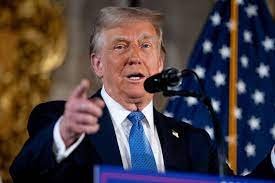The United States Postal Service (USPS), an institution that has served America for over two centuries, is at a crossroads. For years, it has struggled financially, faced delays, and navigated changing times. With the rise of email, online shopping, and digital communications, the USPS’s traditional business model has been challenged like never before. Amid these difficulties, former President Donald Trump’s involvement in the future of USPS sparked heated debates. His proposed reforms were ambitious, divisive, and controversial. Some viewed them as a necessary overhaul, while others feared they could signal the demise of an essential public service.
In this article, we’ll examine Trump’s USPS reform plan and analyze its potential consequences for the American people and the future of the postal service.
The Struggling Postal Service
Since its inception in 1775, the USPS has been one of the most recognizable government agencies in America. Yet, in recent decades, it has been mired in financial difficulties. There are a few main reasons behind these troubles. First, the volume of traditional mail, such as letters and bills, has dropped significantly due to the widespread use of email and digital communication. Additionally, online shopping has resulted in increased demand for package delivery, but the USPS still faces stiff competition from private carriers like FedEx and UPS.
Furthermore, a law passed in 2006, known as the Postal Accountability and Enhancement Act, requires the USPS to pre-fund retiree health benefits for future decades, an obligation that no other federal agency faces. This law has added billions to the postal service’s debt and made it nearly impossible to operate in the black.
In 2020, the USPS posted a staggering loss of $9.2 billion and had accumulated over $87 billion in debt. The situation was worsened by the COVID-19 pandemic, which led to even higher demands on the postal service for both mail-in ballots during the election and package deliveries during lockdowns. With this financial strain, the USPS became a focal point of debate during the 2020 election season.
Trump’s Plan for USPS Reform
During his time in office, Donald Trump was highly critical of the USPS’s operations. He repeatedly called the service inefficient, overstaffed, and a financial drain on taxpayers. Trump’s solution to these problems was a combination of privatization, cost-cutting measures, and increasing postal rates. While some of these measures might have been necessary, they also raised concerns about the long-term effects on the USPS’s ability to serve the public.
Privatization: A Double-Edged Sword?
Perhaps the most controversial aspect of Trump’s plan for the USPS was the suggestion to privatize parts of the service. Privatization would mean that certain parts of USPS’s operations, such as package delivery, could be taken over by private companies. Proponents of this idea argue that privatization would introduce competition and efficiency, reducing the financial burden on taxpayers and streamlining operations.
Advocates also point to the success of other privatized services, such as Amtrak, as evidence that private sector competition can improve performance. They argue that private companies could use their resources more effectively, reduce operational costs, and provide better services for customers.
However, opponents of privatization warn that turning the USPS into a for-profit venture could come with several unintended consequences. First, privatization could lead to increased costs for consumers. Without the protection of government regulation, private companies would likely charge higher rates for services, making it more expensive for people to send mail and packages. In particular, rural areas that rely on USPS for mail delivery could be left behind, as private companies often prioritize urban centers where profits are higher.
Moreover, privatization could lead to mass layoffs, disrupting the postal workforce and leaving thousands of employees without jobs. Many USPS workers have strong union representation, and any attempt to privatize the service would face intense opposition from labor groups. Critics argue that privatizing the USPS would compromise the quality of service, particularly in remote and underserved areas where private companies may have little interest in operating.
Raising Postal Rates: A Potential Solution?
Another central part of Trump’s plan for USPS reform involved increasing postal rates. Over the years, postage costs have risen, but Trump’s administration pushed for additional rate hikes, believing they would help offset the service’s budget deficits. Raising postal rates was seen as a way to generate much-needed revenue, but critics warned that it could create more problems than it solved.
The increase in postal rates would likely have an impact on businesses and consumers alike. For small businesses that rely on USPS for affordable shipping, higher rates could lead to increased operational costs, forcing businesses to either raise their prices or seek out alternative shipping services. Higher costs would also affect everyday consumers who need to send letters and packages, especially those in rural areas where alternative services might not be available or affordable.

read also – Surprise Decision? Trump Might Block U.S. Steel’s Merger Plans
Supporters of higher rates argued that this was necessary to keep the USPS afloat. They suggested that raising the cost of services could ensure the USPS’s long-term viability, without burdening taxpayers. However, critics maintained that while rate increases might provide a temporary solution, they wouldn’t address the root causes of the USPS’s problems. Until the USPS adapted to the digital age and modernized its operations, it would continue to face financial challenges.
Cost-Cutting Measures: Efficiency or Decline?
Cost-cutting was another key element of Trump’s USPS reform plan. The service’s large workforce of over 600,000 employees was often viewed as a significant drain on resources. Trump’s administration pushed for a reduction in staff, with the hope that it would lead to greater efficiency and lower expenses. Additionally, there were proposals to close post offices, reduce hours of operation, and eliminate Saturday deliveries.
Supporters of cost-cutting measures believed that these changes were necessary to make the USPS more financially sustainable. They argued that reducing the size of the workforce and eliminating unnecessary services would help to curb the growing debt. However, many critics warned that these cuts could lead to slower service, particularly in rural areas where post offices are critical to daily life.
The reduction of postal services, such as limiting hours or discontinuing Saturday deliveries, could make it harder for Americans to access essential mail services. Rural communities would be disproportionately affected by these cuts, as they often rely on USPS for their most basic needs, from sending letters to receiving medications and other goods. Moreover, critics feared that such cuts would result in further delays in mail deliveries, especially at a time when the public was depending on the USPS to send ballots during the election.
The Political Battle Over USPS
Trump’s proposed changes to the USPS were deeply political, and the issue became a flashpoint during the 2020 presidential election. Democrats, in particular, vehemently opposed many of Trump’s reforms, fearing that privatization and cuts to services would undermine the USPS’s ability to handle the volume of mail-in ballots during the election. They argued that mail-in voting was critical to ensuring a fair and secure election during the pandemic.
Republicans, however, were more sympathetic to Trump’s approach, believing that reforming the USPS would help reduce government spending and improve efficiency. The battle over USPS reforms quickly became a partisan issue, with both sides accusing the other of putting politics ahead of the well-being of the American people.
One of the most contentious figures in this debate was Louis DeJoy, whom Trump appointed as Postmaster General in 2020. DeJoy, a major donor to Trump’s political campaigns, made a series of controversial changes to the USPS’s operations, including the removal of sorting machines and changes to delivery policies. These actions sparked widespread backlash, especially from Democrats, who saw them as an attempt to disrupt the election process.
Looking to the Future: Can the USPS Survive?
As Congress continues to debate the future of the USPS, it’s clear that finding a long-term solution will be complex. The postal service needs to balance the demands of the digital age with the need for financial sustainability. While privatization and cost-cutting measures may provide temporary fixes, they may not address the underlying issues that have plagued the USPS for years.
Experts believe that the USPS must modernize its services to stay competitive. This could include expanding services like package delivery, offering digital services, and finding new sources of revenue. Others argue that the USPS should remain a public service, with the government stepping in to provide funding when necessary to keep the service running smoothly.
Ultimately, the future of the USPS depends on finding a solution that works for all Americans. Whether it involves reforms to the way the service operates or a renewed commitment to its mission as a public institution, one thing is clear: the USPS is too important to fail. As we move forward, it’s essential that the government and the American people come together to preserve this vital service for future generations.






